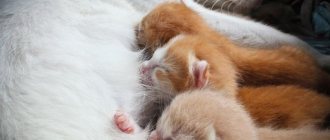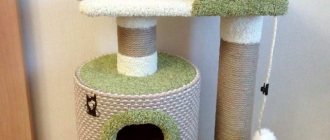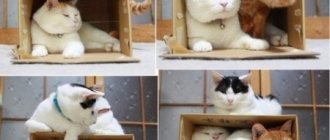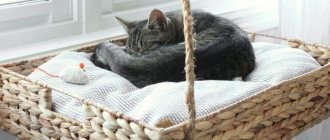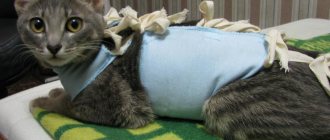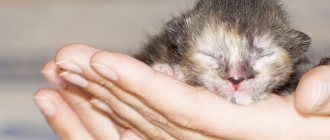It is necessary to prepare the place for the cat's birth in advance, preferably 2 weeks before the birth. This will provide comfortable conditions for the animal and protect future offspring. The maternity house can be purchased ready-made or made with your own hands. To equip and decorate such a home, you need a small amount of materials and basic skills in working with tools. The main thing is to take into account the size of the cat and leave room for offspring.
Possible complications during lambing
Complications during lambing can occur at any stage of birth in both mother and kittens.
Complications from the parturient side may be the following:
- ruptures of the birth canal due to hypertension;
- bleeding;
- refusal of kittens - the cat is not interested in newborns and growls if they are placed near her;
- sepsis;
- uterine prolapse;
- retention of placenta;
- acute mastitis – inflammation of the mammary glands;
- cannibalism.
Newborn problems:
- congenital malformations - cleft palate, development of internal organs outside the body;
- intrauterine infections, due to which kittens are stillborn or die in the first few days;
- abnormal position of the fetus - in such cases the cat will not be able to give birth on its own;
- aspiration (inhalation) of amniotic fluid, pneumonia.
Cleft palate in a kitten
How you can help:
- Before mating a cat, it is necessary to thoroughly examine her and the future father of the kittens for the presence of infections and pathologies that are transmitted genetically.
- During pregnancy, transfer the cat to specialized food for pregnant and lactating cats.
- Take an x-ray a week before the expected birth - this way you can accurately find out the number of kittens in order to understand when the birth should end. It is impossible to determine their number by ultrasound.
- Create the most sterile conditions for childbirth.
- Find “your” veterinarian and enlist his support.
A breed such as the Scottish has two variants of the phenotype - fold-eared and straight-eared. And it requires a special approach when breeding.
It is very important that only one of the parents has lop ears. If you cross two fold cats, then 100% of the kittens will be born with joint pathologies and will hardly live to be three years old
These will be disabled animals. This disease is called osteochondroplasia of Scottish fold cats and is associated with a mutation of cartilage tissue.
Large fruit stuck
You can remove the kitten yourself:
- Put on medical gloves and lubricate the animal’s vagina with Vaseline oil.
- Take the kitten with a clean cloth and gently pull it down, rocking it slightly from side to side. You should not pull the paws.
What not to do:
- Pull the kitten out by the paws.
- Allow your cat to eat more than 2 placentas.
- Use antiseptics intended for humans.
- Hold newborns in your arms during the first hours.
- Turn on bright lights in the room. This leads to the development of cataracts in kittens.
Possible complications after childbirth
Childbirth in a cat does not always go smoothly. Sometimes complications occur, some of which can even threaten the pet’s life. The owner must recognize them in time and try to eliminate the consequences.
Dead kitten
The causes of stillbirth in a cat can be either intrauterine death or death from asphyxia during passage through the birth canal. If a kitten is born without signs of life (does not move, does not squeak for 10–15 minutes), then it should be removed from the cat and other healthy kittens.
I just had a situation where a kitten got stuck in the birth canal and died. We were at work all day and that's when the cat started giving birth. When we returned, at first we didn’t suspect anything. But the cat had some kind of dense lump sticking out under its tail. After about twenty minutes we realized that not everything was going smoothly. My husband got down to business, he performed some manipulations, and the lump was born, but, unfortunately, already lifeless. Fortunately, the next two babies were born without problems.
The kitten can't get out
If the kitten cannot pass through the birth canal and is stuck there, then the cat must be injected with 0.2 mg of oxytocin. When the medicine does not work and the situation is not resolved, it is necessary to urgently contact a veterinarian to solve the problem surgically. It is unacceptable to pull a kitten yourself - this can cause harm not only to the baby, but also to the cat.
The kitten got out, but there is a bubble sticking out
The cat can cope with this problem on its own, however, in the event of a difficult birth, if the animal is too tired, veterinary care may be required, the absence of which is fraught with dangerous consequences.
Required Tools
Before delivering your cat at home, have the following items on hand:
- clean diapers or cloths;
- clean gauze;
- petrolatum;
- scissors;
- thick threads;
- warmer;
- antiseptic for processing;
- clean pipette;
- a separate nest for newborn kittens (for example, a small box);
- cat carrier;
- phone number of a 24-hour veterinary clinic or your veterinarian.
Note! You may need to urgently call a veterinarian to your home or take the woman in labor to the clinic yourself. To do this, keep your phone and a container for carrying the animal ready.
Alarming symptoms
An unqualified owner cannot always help a furry pet. That is why during childbirth you should have the telephone number of the treating veterinarian, or preferably two or three numbers, at hand. Four symptoms are a serious reason to contact a specialist.
Ahead of schedule. Most often, premature birth occurs in a cat due to a frozen pregnancy, non-viability of the offspring, placental abruption, or injury. The stages of labor pass faster already on the 50-55th day, sometimes earlier. Most often, a cat gives birth to dead kittens. The living premature offspring dies in the coming days. It happens that a cat gives birth to just one dead baby prematurely. The rest emerge alive and healthy on time. If your cat gives birth prematurely, have her examined by a specialist to understand further steps. Lack of childbirth. If the pet does not give birth for more than 70 days and if this is not a false “birth” due to an imaginary pregnancy in the cat, then the pregnancy is probably frozen. The cubs most likely died, so it is urgent to save the pet from possible infections and damage to the uterus. Missed birth
It is important to determine when labor is truly over. If the pushing has stopped and the cat is resting, this does not guarantee that all the kittens will come out.
You should observe your mother's behavior. A cat that has not yet given birth reluctantly takes care of the cubs, does not leave the “nest” and does not change position, refuses to drink, and periodically strains. To make sure, you can feel the stomach three to four hours after birth. The elasticity and tension of the muscles indicate that there is still a kitten left in the womb. Discharge. Any colored, pungent-smelling discharge during pregnancy and childbirth is a deviation from the norm. During strong, long contractions (more than an hour) without subsequent labor, blood may flow profusely. In this case, it is also necessary to show the cat to a specialist.
Fetal pathologies do not always depend on the health of the mother and can be inherited from the father. However, the physical and mental condition of the cat affects the successful outcome of the birth.
Therefore, it is important that the pet is healthy before mating. Unfavorable factors for childbirth are old age, obesity, stress, heredity
Even the process of childbirth in a cat, supported by instincts, does not always go smoothly. You should mentally prepare for any outcome. However, do not panic prematurely and do not intervene without reason. Nervousness will be transferred to the pet, and during childbirth she will be confused. Rest assured that everything will go well and the cat will be able to rely on its owner.
What you should always remember
Your task is to maintain “Nordic” calm. Even if you have never seen a cat’s pain before, there is no need to panic. Believe me, our pets perfectly sense the emotional mood of their owners. If you are nervous and panicky, your cat will also be under a lot of stress. This will not help the birth in any way.
Let us immediately warn the “cleanies” that the birth of kittens is a dirty process.
There will be blood, mucus, birth waters. Remember that the birth of a kitten wrapped in a kind of “bag” is normal. These are the placental membranes.
- A cat that gives birth must definitely tear this sac for each kitten, since otherwise the baby may well suffocate.
- Each kitten will have an umbilical cord. As with the placenta, the mother cat must chew the umbilical cord.
- The mother will eat the placenta and umbilical cord. This is also completely normal and nothing to worry about. Eating placentas is a physiological mechanism. In the wild, it prevents other predators from discovering a cat's lair.
Always remember that your cat may behave out of character. She will probably meow loudly, scream, and make other sounds that are uncharacteristic for her. If you hear them, there is no need to panic. Try to remain quiet during labor.
The calmer your pet is, the greater the likelihood of a successful birth. From time to time you can talk to your pet. The sounds of its owner's confident voice will calm the cat down.
Difficulties are rare, but we must not forget about them!
More than 99% of cat births are completed successfully and quickly, even without the intervention of a veterinarian or the owner himself directly at home. But still, never forget that childbirth is a complex process, so the possibility can never be ruled out.
We immediately warn owners: trying to help an animal give birth without having the appropriate experience and qualifications is a very bad idea.
If you don’t know a veterinarian who can come to your aid at any time of the day or night, find the number for 24-hour veterinary help in advance. Ideally (especially if the cat is primiparous), it is generally worth agreeing with a specialist so that he can supervise the entire birth process. Most likely, such a service will not be too cheap, but still the health and life of your pet is much more important.
In addition, it doesn’t hurt to take care of the availability of transport in advance so that, if necessary, you can quickly bring the cat to the clinic. If you don’t have your own car, take care of a quick taxi phone number: in severe cases, the time can be calculated in minutes.
Always try to use the services of the most experienced and competent veterinarians, since poor-quality obstetric care may well lead to the development of extremely serious postpartum complications.
Finally, it doesn’t hurt to set aside a certain amount for veterinary care for your pet and her kittens. Please note that if you call at night and supervise the birth, you may need to spend a little more money. Remember that if necessary, you may need formula (cow's milk is absolutely not suitable), so think about where you can buy it in your city.
The first 24 hours after birth
A cat is considered sexually mature when she is 7 months old and begins to go into heat. However, you should not rush into mating. For example, British cats are able to bear healthy kittens only after 1 year of life.
Owners are usually more afraid of the first birth, since cats have strong instincts that help them overcome the ordeal. If the animal is healthy, then there is no reason to worry. Usually everything goes without complications, so it is enough for the owner to be nearby.
At first, contractions gain momentum in intensity and become more and more frequent. Then, through efforts, the baby is born.
Important! The cat must give birth in a lying position, so you need to watch and not let her sit up. Owners of Scottish and other breeds often have to rid kittens of the amniotic sac if the cat does not do this
Owners of Scottish and other breeds often have to rid kittens of the amniotic sac if the cat does not do this.
The interval between the appearance of kittens can be up to 1.5 hours, so there is no need to worry about this
In the first time after childbirth, it is necessary to provide cozy and calm conditions for mother and babies. You need to put a clean sheet in the box and add a warm heating pad if necessary.
At first, it is necessary to independently apply the babies to the nipples so that they actively feed
The best food to give your cat is:
- milk;
- cottage cheese;
- boiled vegetables;
- chicken meat;
- sour cream.
Important! In the first month after lambing, you should not feed the animal dry food, as it contains a large amount of salt. It is advisable to purchase vitamins for the mother cat that contain calcium.
Despite the fact that childbirth often occurs without complications, consultation with a veterinarian is still necessary. During the examination, the doctor will confirm that the mother and kittens are healthy, because some pathologies are not immediately detected.
Depending on how the birth takes place, the health of the mother cat and the babies depends. Studying the processes and names of each stage of lambing in a pet will help the owner not to get confused at such an important moment and provide first aid. As the cherished date approaches, a person should carefully monitor the cat’s behavior so as not to miss the main symptoms.
Suitable options
In order for the animal to feel good and not worry too much, the birthing area should be properly prepared in a timely manner. Especially if the cat is pregnant for the first time, an inexperienced owner has to deliver the baby .
- A box for giving birth to a cat is the simplest and most convenient option. At the bottom you need to put something warm and soft, for example, an old sweater, and on it - disposable diapers that are easy to remove and change. Before giving birth, it is advisable to lay a fresh one.
- A cage is also a good option for the birth of kittens. When the kids grow up, it is very easy to wash.
- Box. You can place in it not only soft bedding, but also a feeder, a bowl of water, and if the size allows, even a tray. This way the cat can avoid being away from the babies for a long time.
- Baskets. They are equipped with special mattresses, which can later be washed without any problems. However, this is an open option, so the cat will not feel completely safe.
- Tents. For childbirth, you can also use tents - both exhibition and arched. They are easy to close, so the cat will not be able to constantly carry the kittens from place to place. However, an animal can spill water from a bowl or scatter food, and it is quite difficult to tidy up such a “house” while the kittens are in it.
- Breeders often use playpens as a place for childbirth.
The owner must first of all think about the pet, so it is better to refuse a fashionable and beautiful tent in advance if the animal previously felt uncomfortable in it.
When should you contact a veterinarian?
You should immediately consult a doctor in the following cases:
- Premature birth (pregnancy less than 51 days).
- The cat has prolonged contractions, but the kitten is not born for more than an hour.
- The fruit is not positioned correctly (backwards) or is very large.
- The cat's body temperature is less than 37 or more than 39.5 degrees.
- Copious bloody discharge from the vulva with an extremely unpleasant odor.
- Heart rhythm disturbance.
- The cat is weakened, makes no attempts to expel the fetus, and her breathing is weak.
You should call your veterinarian if you don't know if everything is going well. It’s better to play it safe and bother the doctor than to waste time.
Sometimes labor stops for a while. The cat licks the kittens that have already been born, and the rest are born later. This is a variant of the norm if there are no visible signs of poor health.
The amniotic sac did not rupture
In this case, proceed in this order:
- Rip the amniotic sac under your baby's nose.
- Take the kitten in your palm, press it lightly with your fingers and shake it slightly. If there is no reaction, clean the newborn's nose using a syringe.
- Rub baby gently with a clean cloth and then shake again.
- Place the baby on the mother cat so she can lick him.
If the baby does not show signs of life, hold him (not by the paws!) upside down to stimulate breathing.
Signs of the onset of labor
The first time labor usually makes itself felt 24 hours before the onset of contractions. In experienced cats, clear signs appear 1-4 hours before labor. The beginning of the process depends not only on the age of the pet, but also on individual characteristics.
The first signs of impending birth:
- decreased appetite. The cat begins to drink a lot, in addition to water, prefers milk and broth;
- the cat is lethargic and almost constantly lies in the box;
- Before the onset of contractions, you may notice active movement in the abdomen. Thus, the kittens try to take the most comfortable position for birth. This sign is often noticeable already 1-2 days before birth in representatives of large breeds (for example, Maine Coon);
- active licking of the genitals. In this way, the cat cleanses the organ to prevent the development of infections in kittens;
- About an hour before giving birth, the cat's birth plug comes off. Usually it is not difficult to notice, since it resembles a white-pink clump;
- before starting the process, the temperature is reduced to 37 °C. Experts recommend monitoring this indicator to prevent bleeding during and after childbirth;
- by the time of childbirth, the nipples swell as much as possible, and if pressure is applied to them, colostrum will appear;
- 5-6 hours before birth, false contractions may appear. In this case, the cat behaves restlessly, often hunching over, and meowing. The process helps the kittens to finally prepare for birth, and the vascular system of the uterus to contract in a timely manner;
- the main and main sign of the onset of labor is the breaking of water. They can leave either a few hours before or at the birth of the first kitten.
Important! It is necessary to ensure that the cat does not go to give birth in an unsuitable place where access to her will be limited.
Choosing room parameters for our pet
You have probably already decided on your preferred option for a house and are ready to make it yourself. Now you need to decide on the size of the cardboard box that will suit your animal. Cats of different breeds vary markedly in size and behavioral habits.
Thus, individuals of the Bengal and Siamese breeds like to take a position on their hind legs, which means they will like a high house, with “second light”. Some animals like to lie down to their full height, while others prefer to curl up in a ball and lean against the walls of their home.
For example, a Scot will feel great in an area of 45x45cm with a height of 25cm, a larger cat will need housing 50x60cm with a height of 30cm, and a tall Maine Coon may require an “improved apartment” measuring 160x120x60cm. Many cats feel especially confident at heights. In nature, they climb into trees where they feel safe, have a good view and are ready to repel attackers from below.
If your cat has already explained that he likes to sit on the cabinet, then he needs a “skyscraper” higher, right up to the ceiling. By the way, it’s warmer there, that is, more comfortable for the animal. Of course, a tall house should have wide support, or better yet, be attached to a wall or ceiling.
Everyone knows: where the cat’s head goes, the whole animal will go. However, comfortable entrance sizes for an animal range from 15x15 to 20x20cm.
Cat pregnancy calendar by week
Fetal development stages are most often indicated in weeks, and in the early stages days are used. Below we take a closer look at intrauterine development from the very first days.
Development by week
The embryo's cells divide but move freely throughout the uterus. Attachment to the wall occurs only 7-10 days after conception. This process is called implantation and the countdown begins with it. The online cat birth calculator also takes this period into account.
For your information! At this time, the first signs of pregnancy appear in the cat. The expectant mother becomes more capricious, picky, and may hide for a long time in a quiet, dark place.
We invite you to familiarize yourself with Saber-toothed cats: the character and appearance of an extinct species, lifestyle and habitat, causes of extinction || Saber-toothed predators - what do we know about Meganterion?
The fertilized egg increases to a size of 15-20 mm. At the moment, the cat embryo is difficult to distinguish from other mammals. The gradual development of internal organs, including the brain and heart, begins.
Important! An ultrasound at this stage shows a heartbeat of about 230 beats/min. By the end of the 28th day, the baby’s paws, pads, and claws begin to form.
The cat's behavior does not change during this period. Possible toxicosis
By the end of the 28th day, the baby’s paws, pads, and claws begin to form. The cat's behavior does not change during this period. Toxicosis may occur.
At 5-6 weeks, sensory organs gradually form. As you know, cats have well-developed hearing and a sense of balance. Also at this stage, gradual preparation for growing a mustache occurs, and soft claws appear.
The bones and spine are clearly visible on the x-ray. The fur is already fully formed. In general, on the 50th day, kittens are ready to be born, but this point also depends on the breed.
For example, the straight-eared British cat, Bengal, Maine Coon, and Scottish Fold grow a little slower than other members of the cat family and, accordingly, live longer. For this reason, you should not fit the pregnancy periods of sphinxes and “British” women into a single framework.
The mother cat gradually begins to prepare for childbirth. The body shows the first symptoms, such as test contractions. The owner should carefully monitor the behavior, since in the prenatal state the pet is looking for a secluded place
It is also important not to create stressful situations for your pet and to feed it well.
Developed fetus
By this time, those kittens that belong to the late breeds are already born. The cat's behavior during this period becomes calmer. The expectant mother expects the birth of her babies in a certain place, almost without leaving her bed.
For most cats that do not belong to certain breeds, the 13th week is already exceeding the norm. Further gestation can lead to the development of an overly large fetus, which can cause harm during childbirth.
Important! If the period has clearly exceeded the established period, it is better to seek help from a doctor.
Hygiene
For 10 days after birth, the pet experiences discharge. This is a normal process of self-cleaning of the uterus, which, when contracting, pushes organic matter (lochia) out. At first, the lochia is brownish or red with green streaks. Gradually, the discharge becomes lighter, then completely colorless. Clean by nature, the cat grooms itself, and the litter remains clean. But a weakened or primiparous animal must be helped by removing discharge from the inner thighs and vulva area with a moistened towel. It is also necessary to monitor the cleanliness of the litter. It is best to change it when the cat has left the bed for a while.
Attempts by a cat to go outside should be resolutely stopped, as “gulena” will carry microorganisms on its paws that can harm the babies.
Why is it needed?
It is necessary to prepare a home for the birth of kittens for the following reasons:
The design provides little kittens with protection and comfort.
- offspring safety;
- comfortable life for mother and offspring;
- rest and feeding of animals.
A maternity house is not just a maternity hospital for an animal, but a place where the expectant mother can feed and protect her kittens. It is advisable to prepare such a place for your pet 14-21 days before the onset of labor. The maternity house should be equipped with a heating pad if the birth of small cats occurs during the cold season. It is advisable not only to properly prepare the box for the birth of offspring, but also to prepare brilliant green, round scissors, sterile napkins and flannel cloths, gloves, the necessary medications, a pipette and an enema. These materials may be needed to help your cat give birth. With the right approach, it is better to deliver the baby with a veterinarian, and then move the born kittens and mother into housing.
Basic Rules
When choosing a place where the cat will give birth and the kittens will spend the first weeks of their lives, it is important to adhere to the following rules:
- It should be warm and protected from drafts.
- Definitely safe and comfortable. It is very important to equip the maternity area where no one can accidentally step on the babies.
- Must be quiet and in a dark place.
- It is best to choose natural fabrics and materials.
- The design should be such as to enable the owner to do cleaning without disturbing the animals.
In this case, both the mustachioed mother and the kids will be comfortable. The place for childbirth should be prepared in advance, this will help accustom the animal to its new “house”.
House for giving birth to a cat (nest)
The cat’s birthing house (nest) must be prepared 2-3 weeks before the cat’s expected birth. To do this, you can use an exhibition tent (sterilized or never seen at exhibitions), an arena, a special cage or an ordinary spacious box.
The house for giving birth to a cat should be spacious enough, because... it will contain a cat with kittens and some other items (bowls, tray, heating pad, etc.).
Both the owner and the cat should have equal and convenient access to what is inside the house for the cat to give birth, and it is advisable to create obstacles for the kittens. Therefore, a door is usually cut out in a cardboard box at a short distance from the floor, and tents and playpens are opened just enough so that it is convenient for the cat to get in and out, and the kittens cannot crawl out of it.
A soft but thin cloth is placed at the bottom of the cat’s birthing house, which is easy to wash; instead of cloth, you can use disposable diapers. You should not cover a cat’s birthing house with thick, heavy fabrics (for example, a blanket), because kittens can easily get tangled in the folds and suffocate.
You can put a heating pad in the cat's birthing house, especially if the birth occurs during the cold season. It is better to wrap the heating pad in a cloth so that the kittens do not get burned.
In addition, you can put a tray and bowls with food and water in the cat's birthing house. Some cats eat, drink and go potty between contractions, so to prevent the birth of the next kitten from taking place “on the road,” it is better to place everything closer.
The house for giving birth to a cat should be in a warm, dry and calm place, without drafts.
Some breeders recommend preparing another box with bedding and a heating pad. This box is intended for kittens that have already been born, since during contractions and next births the cat may accidentally crush them.
Immediately before the cat gives birth, it is necessary to block her access to hidden places in the apartment: under the bathtub, in the closet, etc., because the cat may decide to give birth there, which is not at all hygienic.
Available means
A birthing box can be made from improvised materials and old suitcases, drawers from a chest of drawers or a playpen available in every home. The last option is recognized by breeders as the most successful. A folding playpen with a zippered side entrance can be the perfect place for your cat to give birth. Sidewalls made of durable mesh allow you to keep an eye on your cat, do not tear, are easily disinfected and provide free air flow.
Regardless of what kind of place for childbirth the owner has equipped, it must be kept clean. Do not allow the inside of the “birth nest” to be treated with strong-smelling disinfectants. Rugs, mattresses and diapers are washed only in neutral, odorless detergents. Diapers will have to be changed daily. The main thing is to provide the cat with peace and comfort so that it does not get nervous.
The animal may not share the owner’s delight in the new tent or house. Some cats stubbornly go under the sofa, into an old closet or behind a long curtain near the radiator. You should accustom your pet gradually, starting 2-3 weeks before birth. Some people feed the cat treats in the house so that she gets used to it faster.
Tents are convenient in this regard; noting the approach of childbirth, the owner can lock the cat in the house during his absence. If you carefully study the habits and needs of your cat, you can equip a comfortable and safe place for childbirth in a city apartment, as close as possible to the natural needs and instincts of the animal.
It is necessary to prepare the place for the cat's birth in advance, preferably 2 weeks before the birth. This will provide comfortable conditions for the animal and protect future offspring. The maternity house can be purchased ready-made or made with your own hands. To equip and decorate such a home, you need a small amount of materials and basic skills in working with tools. The main thing is to take into account the size of the cat and leave room for offspring.
Preparing cats for pregnancy
Special attention should be paid to this stage when planning pregnancy. It is necessary to pre-treat the cat with anti-helminth medications and vaccinate
It is also recommended that a veterinary clinic check for inherited diseases. This is especially true for owners of such breeds as: British, exotic, Persian, Sphynx, Siamese, Neva Masquerade, Norwegian Forest, Abyssinian, Bengal, Maine Coon. It is advisable to check your cat for viral infections (herpesvirus, coronavirus, feline leukemia virus and viral immunodeficiency).
These infections can be transmitted to offspring and cause pathological pregnancy and congenital deformities.
Professional support
The most important thing for an inexperienced owner is to enlist the support of a professional. You should agree with at least two veterinarians about telephone consultations and possible house calls in the middle of the night (the law of meanness in action: veterinarians often leave the city or do not answer calls on the very day when signs of labor appear)
If the cat was purchased from a cattery, be sure to inform the breeder about the upcoming birth. Not a single responsible breeder will refuse to help his “child”, and will definitely consult the owner by phone, giving the most valuable advice and moral support.
What to prepare before giving birth to a cat
There is a popular proverb: “Only cats are born quickly.” In general, this proverb is true, and pets can often give birth to offspring without the help of an owner or veterinarian. But this does not always happen, especially if the cat has previously had problems with childbirth.
Did you know? There are about 600 million domestic cats living on our planet.
When preparing for childbirth, first of all, it is necessary to arrange a maternity area, which in the future will become a place of residence for small cats. Such a place should be secluded, otherwise your cat will begin to look for a suitable place for itself, dragging newborn kittens throughout the house. You can use large cardboard boxes or something like that for the “maternity ward.” Many mustachioed friends like to give birth in boxes for storing clothes, so if your cat has this feature, then it is better to immediately prepare such a box for her, so as not to confuse newborn kittens with pants or socks.
In addition to the “maternity ward”, to give birth you will need:
- the veterinarian’s phone number and knowledge of the route to the nearest veterinary clinic;
- disposable diapers;
- sterile gauze wipes (at least 20x20 cm in size);
- silk threads of sufficient thickness (needed for tying the umbilical cord);
- special rounded scissors;
- medical alcohol for disinfecting medical instruments;
- hydrogen peroxide and chloramphenicol ointment;
- streptocide (in the form of granular powder);
- syringe (needed when removing excess fluid from the nasal passages of newborn kittens);
- metal vessel (volume of at least 1 liter);
- warm heating pad for small kittens;
- "Gamavit", "Oxytocin" and calcium gluconate.
Examples of homemade housing for a cat made from boxes
A practical solution is to provide the cat with a homemade house made of corrugated cardboard. There are different ways to approach this type of work, but it is best to familiarize yourself with the existing options before getting started.
In the simplest case, you just need to cut the entrance - and the house is ready. In this case, two holes were made not at all by chance: a cautious animal is afraid of being blocked in its resting place and prefers the presence of an emergency exit.
By turning a few boxes upside down, we get a home for a family of cats. It's a good idea to provide your kitten with a viewing area using a corrugated box lid and paper cups. Of course, the structure should be secured with glue. “Blinds” made from strips of paper over the entrance are a wonderful toy for kittens.
A little colored paper and watercolors will help bring the look of a cardboard box cat house to life. It is necessary to correctly link the finishing design of such a house with the interior of the room.
An important element of improvement for a cat is the presence of soft bedding. This work probably needs to be entrusted to the female half of the family.
Possible complications and procedure
Complications can occur at any stage of labor. All pathologies of cat pregnancy can be diagnosed and solved.
Dystocia (obstructed birth) is classified in origin as maternal and fetal, caused by problems with the cat or intrauterine development of the kittens. It may be caused by obstruction of the birth canal or functional inertia of the uterine muscles.
Obstructive dystocia is caused by a disproportion between the size of the kittens and the maternal birth canal.
Functional dystocia manifests itself in rare and weak contractions of the uterus. For dystocia, radiography and cesarean section are indicated.
Inversion of the gravid uterus and uterine rupture can cause serious consequences in the last stage of pregnancy. When the uterus is torsion, the cat is unable to deliver the fetus or fetuses, as a result of which her condition worsens and the kittens die in the womb. Uterine rupture occurs rapidly, causing the fetuses to fall into the abdominal cavity.
The cause of rupture can also be uterine torsion. Excessive bleeding leads to death in the giving birth cat and her offspring. In these cases, urgent surgical intervention is required.
If a cat cannot give birth to a kitten on her own, she needs help. The half-stuck kitten is wrapped in sterile gauze and gently stretched during each contraction.
It must be remembered that there is always a risk of the kitten drowning in amniotic fluid if the process of separating the placenta and clearing the kitten's airway takes too long. A dead fetus in utero can itself lead to functional or obstructive dystocia.
It happens that the fetus dies in the womb even before labor begins. This occurs as a result of infectious diseases suffered by the cat during pregnancy or intrauterine growth retardation.
The cat's suppression of the natural physical process of birth can cause the kitten to be delayed as it passes through the mother's pelvis. The cat feels physical pain and consciously refuses to try to give birth or waits for outside help, without which the kitten will die.
Kitty
A cat that has become a mother begins to wash the newborn kittens from the amniotic sac with care and diligence. In this situation, human intervention is not required. In situations where the mother cat does not show her maternal instinct or the kitten is not breathing, she needs prompt help. You should imitate the actions of a cat:
- Clear the kitten's nasal passage and mouth of mucus. Any liquid that enters the respiratory tract must be sucked out using special equipment. From available means, you can use a catheter attached to a syringe.
- Cut the kitten's umbilical cord at a distance of 4-5 cm from the belly, cauterize it with iodine or peroxide.
- Stimulation of breathing is provided by stroking the kitten's abdominal cavity. If he is not breathing, the airways are first cleared of mucus. You need to breathe air into the kitten's nose and mouth. You should not inhale a large volume of air - the lungs of a newborn kitten are very tiny.
- Absence of heartbeat is a direct indication for chest compressions. The kitten's chest is squeezed rhythmically with the thumb and forefinger. Pressure on the chest alternates every 10-15 seconds with inhalation of air. Resuscitation actions are carried out within five minutes in the absence of a heartbeat, within 20 minutes in case of a weak heartbeat. An effective way is to use doxapram drops. They are dripped onto the kitten's tongue.
- Provide the kitten with physical contact with its mother or ensure that the room temperature is kept warm. Newborn kittens do not know how to properly regulate their heat exchange.
How can you tell if your cat is going into labor?
At about 7-9 weeks of pregnancy, kittens actively move in their mother’s belly. When the animal is at rest, movements can be seen even from the side. Immediately before giving birth, the cat becomes restless. Breathing is rapid, appetite is reduced. The animal rushes about, looking for a secluded place.
There are other signs that labor is approaching:
- Rectal temperature is about 37 degrees 1-3 days before the birth of the offspring.
- Redness of the genitals.
- Swelling of the mammary glands. A few hours before giving birth, the cat periodically hunches over. This phenomenon is called training contractions.
- Decreased appetite (drinking regime remains the same).
If all of the listed signs are expressed, this is a signal that your pet will soon give birth.
How to make a cardboard house for a cat with your own hands
It would be great if a cat house would become an object of creativity for the whole family. Dad should be trusted to work with a knife, mom can provide a soft fabric bed for the cat, and the children can start painting the cat’s home.
We will look at the manufacturing technology of the house shown in the photo. In the same way, you can assemble any option presented above.
List of necessary tools and materials
To assemble a house from cardboard boxes we will need:
- two corrugated boxes with dimensions of about 45x45x45cm;
- white and yellow acrylic paint;
- several sheets of pink paper;
- scissors;
- stationery knife;
- wide tape;
- brush or piece of foam rubber;
- marker.

